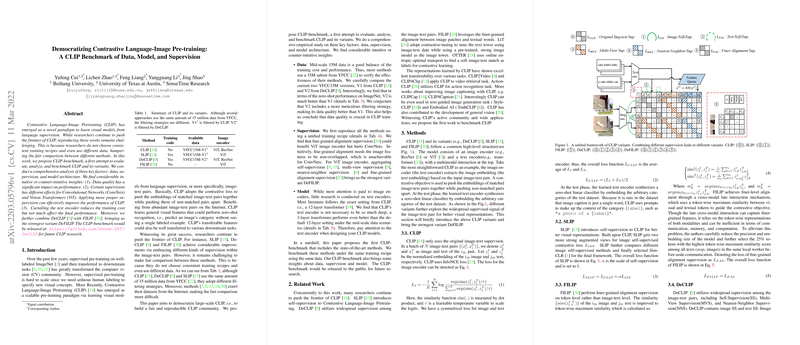Overview of "Democratizing Contrastive Language-Image Pre-training: A CLIP Benchmark of Data, Model, and Supervision"
This paper addresses the challenges and inconsistencies involved in reproducing and evaluating CLIP (Contrastive Language-Image Pretraining) models. The authors present the CLIP-benchmark, a comprehensive framework designed to facilitate fair comparison and evaluation of CLIP and its variants. This paper examines three paramount factors affecting CLIP: data, supervision, and model architecture.
Key Findings
- Data Quality: The research highlights the significant role of data quality in the effectiveness of CLIP models. The authors compare two versions of the YFCC15M dataset, revealing that the version filtered by DeCLIP demonstrates superior quality, leading to better zero-shot performance on ImageNet. This underscores the importance of meticulous filtering strategies for enhancing data quality.
- Supervision Impact: Various supervision strategies are investigated using a unified training recipe. The paper affirms that additional fine-grained alignment supervision benefits Vision Transformer (ViT) image encoders but may hinder traditional convolutional networks (ConvNets). The introduction of the DeFILIP variant, integrating supervision from both DeCLIP and FILIP, is shown to achieve the highest performance, reflecting the compounded impact of multiple supervision techniques.
- Model Architecture: Surprisingly, the research finds that text encoder depth can be reduced without significant performance loss, particularly when employing more supervised signals as in DeCLIP. A 3-layer transformer outperforms the default 12-layer setting under certain conditions, which indicates potential for reducing computational costs.
Implications and Future Directions
The implications of this research are multifaceted. Practically, the findings suggest that optimizing data quality and restructuring model components can greatly enhance CLIP performance without monumental computational expense. The various supervisions integrated into DeFILIP demonstrate a viable pathway for future pre-training methodologies that may allow broader applicability and scalability in real-world applications.
From a theoretical perspective, these insights contribute to a deeper understanding of the interactions between model architecture and the types of supervision signals used. This invites future exploration into hybrid models that balance efficiency and performance, as well as the development of more refined data filtering strategies to leverage internet-scale datasets effectively.
Conclusion
This paper successfully establishes a CLIP-benchmark, enabling a standardized evaluation framework for future CLIP research. Through meticulous analysis of data, supervision, and model architecture, the authors provide valuable insights and a strong baseline in the form of DeFILIP. This work offers a promising foundation for advancing contrastive pre-training paradigms, emphasizing the critical interplay between data quality and model architecture in achieving optimal performance.
